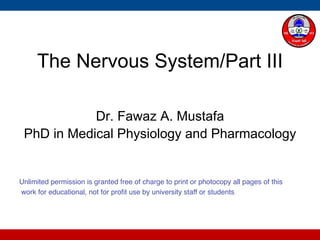The document discusses various types of sensations detected by the nervous system including pain, touch, proprioception, vibration, and thermal sensations. It describes:
1) The pathways for each sensation from receptors to the central nervous system, including the roles of first, second, and third order neurons.
2) Characteristics of different sensations such as poorly localized deep pain versus well-localized superficial pain.
3) Structures involved in each pathway such as dorsal root ganglia, dorsal columns, spinothalamic tracts, and various brain regions.










































